Magic Tea is an interactive installation aimed to invite transformative experiences during the everyday act of preparing and drinking tea (fig. 1). The first design included several instances of entrainment to promote slow breathing. From previous user tests, it became clear that many participants didn’t notice the entraining stimuli or that the stimuli themselves were unclear.
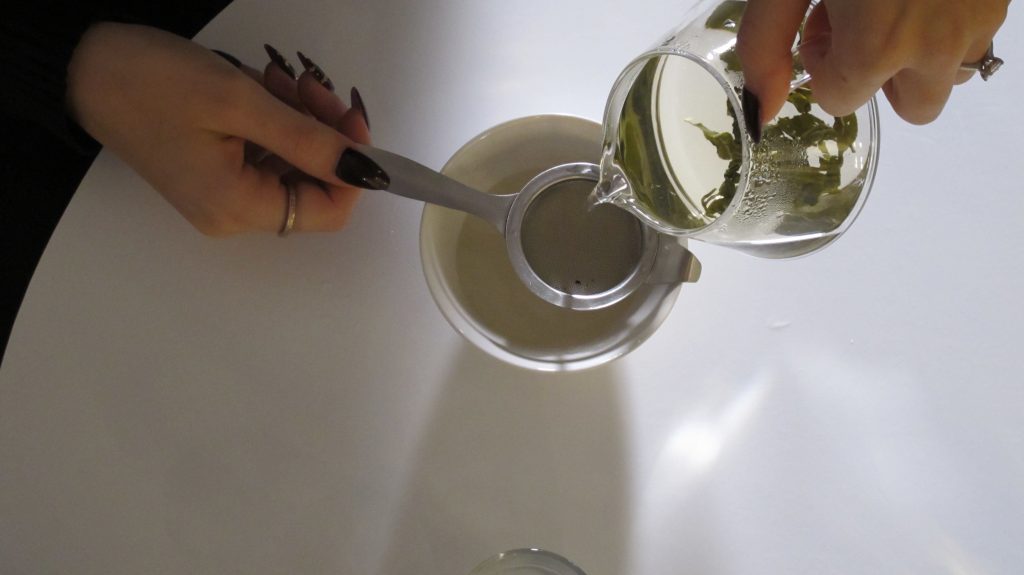
The experiment described in this blogpost explores how this mechanism can be more effective in the next design. Use of the entrainment mechanism to induce slow breathing may better prepare the mind and body of the participants for transformative experiences.
Defining entrainment
Entrainment refers to situations where two or more oscillators in the same field adjust to a common rhythm [1]. The human body also contains oscillators. Two of the most obvious are respiration and pulse. Breathing is part of the autonomous function of the body but can also be controlled voluntarily. Slowing down and deepening the breathing (paced breathing) can reduce stress and increase well-being. [1]
Why entrainment?
Numerous studies have shown that the body is inclined to synchronize with external rhythms induced by for example music [2] or even a tapping sound [3]. This way the body effortlessly and even subconsciously attunes to a slower rhythm which has a beneficial effect on body and mind. However, lowering RR has proven difficult and a drop of one cycle is considered significant [4]. A feeling of relaxation is a requirement for entering altered states of consciousness [5]. Through the mechanism of entrainment, relaxation will follow as a result of reducing the respiratory rate (RR).
Entrainment implementation in the first design
Pirhonen and Tuuri [1] describe various schematic movement patterns which are associated with the kinaesthesia of breathing. For example, ascending and descending reflect the rise and release of tension in the breathing cycle. The first model used the rising and falling of the volume of an audio track to mirror this pattern. A field recording of the sound of the wind blowing through pine trees was manipulated in such a way that the sound increased for 5 seconds and decreased the next 5 seconds, mimicking a slow breathing rate of 6 breaths per minute which is considered to have optimal effects on reducing heart-rate [6]. The looping sound was continuously playing in the background while users prepared tea. Interviews with participants made clear that the sound was hardly noticed: users were too busy preparing the tea and the sound was drowned by other sounds coming from the environment or the preparation process. It is therefore hard to determine if this intervention had any effect on the mind-states of the participants.
New design
Because entrainment is shown to be an unobtrusive and effective way to induce relaxation as a result of slow breathing [1] it will be implemented in the next design iteration. As in the previous version, the main aim of the breath entrainment is lowering RR in users because this promotes relaxation which may improve the effects of the installation. The following improvements will be explored:
- Its place in the interaction scenario. Instead of inducing entrainment through a background sound make the entrainment phase a dedicated part of the scenario and allow the user to focus on it.
- Use a multi-modal approach to strengthen its effect.
- Use a sound which has more relation to the tea preparation process.
This post describes the exploration of the last two improvements (the first improvement will be tested with the next prototype.)
Entrainment experiment
Participants were invited to take part through a personal email message and posts on social media platforms. The email explained the protocol (below) and the privacy policy.
The experiment aimed to answer the question: Does listening to slow rhythmic sounds entrain the listener and slow down normal breathing rate? The hypothesis was that:
a. Entrainment will be stronger with multiple stimuli.
b. This will result in a lower respiratory rate compared to baseline.
To test the effect of this multi-modal approach without having to build a new installation a set of videos with different stimuli was designed. For four days participants would watch and listen to four different videos. After watching the clip participants were asked to count their breathing cycles (breathing in and out counted as one breath). The videos were embedded in an online form, one for every video, where participants could fill in their RR and make optional remarks. At the start of the day instructions and a link to the online form were emailed to each participant.
Contents
Instead of using the sound of wind the sound of ocean waves was used. Water is one of the two ingredients used for making tea and sounds relating to water have more connection to the actions performed. A field recording of a single wave was manipulated in such a way that the sound increased the first 5 seconds and tapered to silence in the last five seconds. This sound clip was looped for 3 minutes.
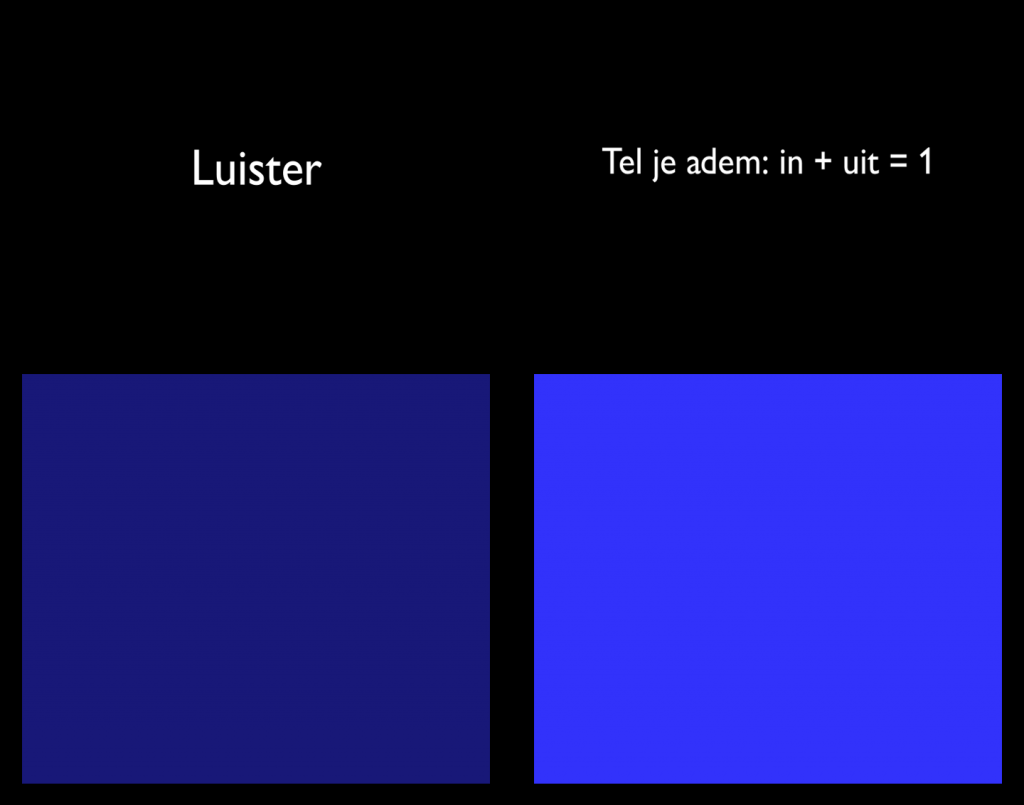
The visual stimulus consisted of a blue coloured screen which faded in from black to blue in 5 seconds and back from blue to black in the next five in more or less in sync with the sound. The control condition consisted of an existing recording of monotonous chanting by Buddhist Monks. The tones last for 15 seconds at the same volume and are repeated.
Protocol
- 1 minute breath count (baseline)
- 3 minutes blank video with no sound
- 1 minute breath count
- 3 minutes blank video with looping wave sound
- 1 minute breath count
- 3 minutes looping wave sound plus pulsating blue light animation
- 1 minute breath count
- 3 Minutes blank video with Buddhist Chant track (control condition)
- 1 minute breath count
Results
On the first day, 14 participants took part. Three participants dropped out resulting in 11 data sets (F=10, M=1) which are described in this section.

The first thing to note is the very low average baseline value of 10,36 breaths per minute (min 6, max 20). In the general public, this average lies between 10 and 20 breaths per minute [5]. Even so, RR dropped by 1.72 breaths after the first intervention which consisted of a three-minute blank, silent video.
Day two and three have the same results for average RR. Compared to baseline there is a drop of 2.45 breathing cycles. Both days show a 7,1% greater drop in breath-cycles per minute compared to the silent condition. At 7.55 breaths day four shows the biggest drop in RR (2.81) compared to baseline.
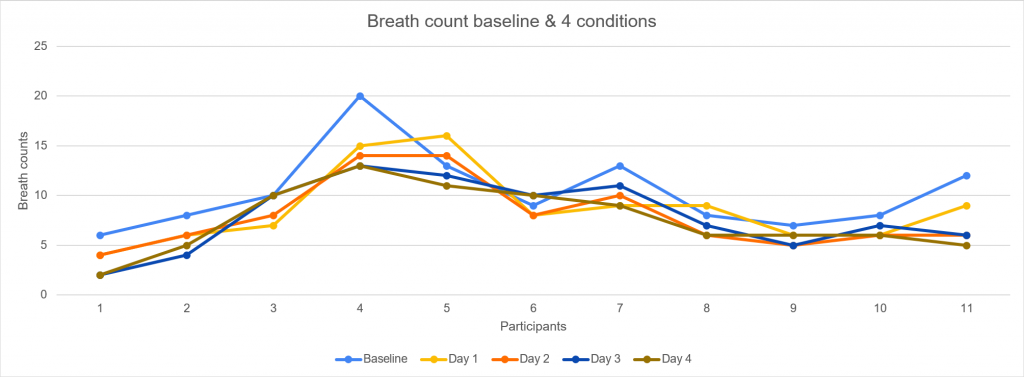
Comments on the audio tracks and the combination with the pulsating light were mostly positive. One participant found the sounds of the waves too rough and another disliked the repetitiveness of all the sounds. The act of counting one’s breath was reported as a bit stressful. Participants also found it hard to continue to breathe normally while counting. One participant reported the tendency to deliberately breath more slowly.
Follow up questions
Because the control condition turned out to produce the lowest RR two follow up questions were posed to the participants in an online questionnaire to which all participants replied:
- Which video did you find the most relaxing? (Pick one of four days, optional comments)
- What did you feel about the length of the video? (Choose either: too long, too short, exactly right, optional comments)
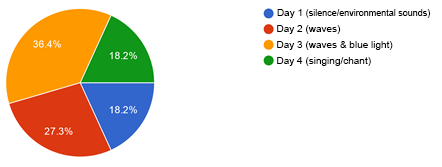
Figure 4 shows that even though the RR wasn’t at its lowest participants experience the multi-modal condition as the most relaxing with the wave sound condition as second most relaxing.
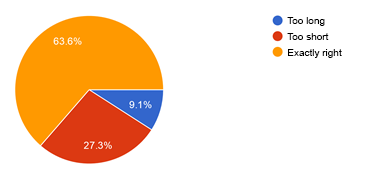
Most participants found the length of the intervention just right (fig. 5), some found it even too short. It should be noted that preferences of duration did vary between stimuli for some.
Conclusion and discussion
This experiment looked at the effect of various stimuli on respiratory rate. Even though the baseline rate was already below average every intervention caused a clear drop in breathing cycles. Three minutes of just sitting and listening to environmental sounds caused a drop in respiratory rate. From that, we may conclude that just sitting quietly and attentively has a positive effect on reducing RR.
There was no difference in breathing rate between the audio and multi-modal stimulus using the wave sound. Judging from comments made on the latter condition this might be because the visual stimulus caused some distraction for some while it was helpful for others. However, in neither of these conditions did their RR rise above baseline (fig. 3). The follow-up questionnaire made clear that the subjective experience of relaxation was highest in the multi-modal condition. Together with the 23.7% drop in RR, this stimulus seems most suitable for implementing in the installation.
The lowest breathing rates were scored during the control condition on day four. The main differences between this sound and the waves were that it was human-produced and that individual sounds lasted longer. Also, there was no change in volume during the sound. The simplified soundscape may have contributed to the lower RR values and participants found it aesthetically pleasing. One user associated the sound with breathing which may have made entrainment easier.
Counting one’s breath was not part of the intervention but did have a big influence, of which the low baseline values are an example. Comments indicated that it made participants highly aware of their breathing and some forced their breathing, trying to slow it down. To get more accurate results the counting should best be done without the participant being aware by using a sensor for example.
The distress caused by the blue light might be caused by the display medium. In the installation, the light will be integrated into the objects on the table which may reduce the glare. A video recording of the blue light in one or more of the objects may have resembled the intended application better and produced more accurate results.
References
[1] Pirhonen, A., & Tuuri, K. (2011). Calm down – Exploiting sensorimotor entrainment in breathing regulation application. Lecture Notes in Computer Science (Including Subseries Lecture Notes in Artificial Intelligence and Lecture Notes in Bioinformatics), 6851 LNCS, 61–70. https://doi.org/10.1007/978-3-642-22950-3_7
[2]Larsen, P. D., & Galletly, D. C. (2006). The sound of silence is music to the heart. Heart (British Cardiac Society), 92(4), 433–434. https://doi.org/10.1136/hrt.2005.071902
[3] Bardy, B. G., Hoffmann, C. P., Moens, B., Leman, M., & Dalla Bella, S. (2015). Sound-induced stabilization of breathing and moving. Annals of the New York Academy of Sciences, 1337(1), 94–100. https://doi.org/10.1111/nyas.12650
[4] Czub, M., & Kowal, M. (2019). Respiration Entrainment in Virtual Reality by Using a Breathing Avatar. Cyberpsychology, Behavior, and Social Networking, 22(7), 494–499. https://doi.org/10.1089/cyber.2018.0700
[5] Cosimano, M. (2014). My Experience as a Guide in the Johns Hopkins Psilocybin Research Project. MAPS Bulletin Vol. 24, No. 3
[6]Russo MA, Santarelli DM, O’Rourke D. The physiological effects of slow breathing in the healthy human. Breathe 2017; 13: 298–309.
Supported by Avans University of Applied Sciences, Centre of Applied Research for Art